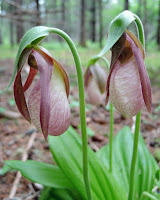My affinity for the world
of nature goes back a long way. As a young fellow my enthusiasm for
birds and wildflowers mystified HJ, my manly father, and induced him to give me
a moniker inspired by a cartoon character, readers as long in the tooth as
myself may dimly recall. Bred to do battle in the bull ring with matadors, toreadors
and picadors, Ferdinand much preferred lolling among wildflowers. He had no interest
whatsoever in fighting. My dear old dad decided to anoint me Ferdinand the Bull. I formed the
impression my new nickname was not entirely complimentary.
In his own youthful years HJ was more drawn to brawling
and fighting than he was to birds and flowers. Sadly, as late as his fifteenth
year, the chip off the old block was not just the smallest boy in Miss Kell’s
Grade 11 class at Riverview high school but the smallest person. For a while my year-and-a-half-younger twin sisters stood
taller than I did. Any time I got into a scrape with the neighbourhood bully
boys I invariably came out the loser. HJ asserted that I must be the milkman’s
son, not his, but given that he had had the good sense to marry Doris Irene he
knew better than anyone that for better or worse I was and still am no one’s
son but his. The poor man.
In the sense that HJ intended, I am still Ferdinand the
Bull. I still feel there is hardly a better way to spend an hour or three than
to grab the binocular and camera, step into the gumboots and go for a ramble in
my woods and bogs. Here at Big Bras d’Or I do it every day. I revel in close
encounters with pileated and hairy woodpeckers, Blackburnian and magnolia
warblers, song and white-throated sparrows. And let’s not forget red-backed
salamanders and pickerel frogs, red squirrels and varying hares.
The succession of wildflowers is pretty much the same
show I see every year at this time but I never tire of it. The early stars of
my woods—bluebead lily, bunchberry and strawberry—have had their time in the
sun and will soon be eclipsed by devil's paintbrush, lupine and the first
fireweed. I am not jaded because the parade is one I’ve seen before. Not in the
least.
Every year I have a small number of a certain
wildflower—just a single clump, perhaps two—that I look forward to seeing even
more than all the others. It has been a cold June here on Boularderie Island;
the wildflower I count the showiest, the grandest of them all has been slow to
bloom. Almost every day I go to the secret location to check on the progress of
my floral friend. I photograph the group every time. Today at last, three weeks
after my arrival here, Cypripedium acaule—the
pink ladyslipper—is finally in bloom. I rejoice. Any number of events might
have turned my little group into a casualty but, no, it has come through. The
2018 edition is every bit as resplendent as all the others that preceded it.
Except for its unusual beauty, pink ladyslipper is not a
rare flower. Doubtless other pink ladyslippers are blooming in nearby woods not
my own. C. acaule is an orchid, the
flower family I count as my favourite. Its surroundings here at Bigador—the
floor of a fir and spruce wood—is just the sort the flower generally prefers.
The image I took today of my very own ladyslippers will do a better job than
any words I might muster to convey just how exquisite C. acaule is. Decide for yourself.
I am glad the timing of Jan’s arrival in Cape
Breton—later today—is perfect. It will be dark when she lands at our cabin in
the woods, but ah, tomorrow morning I can hardly wait to introduce my mate to
the latest crop of our fabulous floral friends.











